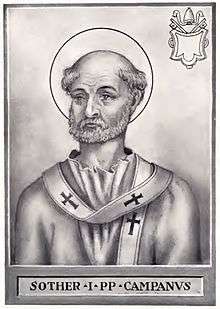Pope Soter
| Pope Saint Soter | |
|---|---|
 Fictional portrait (Artaud de Montor 1842) | |
| Papacy began | c. 167 |
| Papacy ended | 174 |
| Predecessor | Anicetus |
| Successor | Eleuterus |
| Personal details | |
| Birth name | Soter |
| Born | Fondi, Campania, Roman Empire |
| Died |
c. 174 Rome, Roman Empire |
| Sainthood | |
| Feast day | 22 April |
Pope Soter (Latin: Soterius; died c. 174) was the Bishop of Rome from c. 167 to his death c. 174.[1] According to the Annuario Pontificio, the dates may have ranged from 162–168 to 170–177.[2] He was born in Fondi, Campania, today Lazio region, Italy.[3] Soter is known for declaring that marriage was valid only as a sacrament blessed by a priest and also for formally inaugurating Easter as an annual festival in Rome.[4] His name, from Greek σωτήρ "saviour", would be his baptismal name, as his lifetime predates the tradition of adopting papal names.
Roman Martyrology
Saint Soter's feast day is celebrated on 22 April, as is that of Saint Caius.[5] The Roman Martyrology, the official list of recognized saints, references Soter: "At Rome, Saint Soter, Pope, whom Dionysius of Corinth praises for his outstanding charity towards needy exiled Christians who came to him, and towards those who had been condemned to the mines."[5]
It has often been supposed that all the earliest Popes suffered martyrdom, but the Roman Martyrology does not give Pope Soter the title of martyr.[5] The book detailing the 1969 revision of the General Roman Calendar states: "There are no grounds for including Saint Soter and Saint Caius among the martyrs."[6]
Reaction to the Montanist movement
The Montanist movement, which originated in Asia Minor, made its way to Rome and Gaul in the second half of the 2nd century, during the reign of Eleuterus. Its nature did not diverge so much from the orthodoxy of the time for it to initially be labeled heresy. During the violent persecution at Lyon, in 177, local confessors wrote from their prison concerning the new movement to the Asiatic and Phrygian communities as well as to Pope Eleuterus.[7] The bearer of their letter to the pope was the presbyter Irenaeus, soon to become Bishop of Lyon. It appears from statements of Eusebius concerning these letters that the Christians of Lyon, though opposed to the Montanist movement, advocated patience and pleaded for the preservation of ecclesiastical unity.
When the Roman church took its definite stand against Montanism is not precisely known. Tertullian records that a Roman bishop sent some conciliatory letters to the Montanists, but based on the complaints of Praxeas "concerning the prophets themselves and their churches, and by insistence on the decisions of the bishop's predecessors" forced the pontiff to recall these letters.[8] Another ancient source states that "Holy Soter, Pope of the City, wrote against them a book, as did the master, Apollonius of Ephesus. Against these wrote the priest Tertullian of Carthage. Who in all ways wrote well, wrote first and wrote incomparably, in this alone did reprehensibly, that he defended Montanus".[9] At Rome, the Gnostics and Marcionites continued to preach against the Catholic Church.
See also
References
- ↑ Chapman, John (1908). "Caius and Soter, Saints and Popes" in The Catholic Encyclopedia. Vol. 3. New York: Robert Appleton Company.
- ↑ Annuario Pontificio 2012 (Libreria Editrice Vaticana, ISBN 978-88-209-8722-0), p. 8*
- ↑ Biography: Pope Soter
- ↑ Pope Saint Soter » Saints.SQPN.com
- 1 2 3 Martyrologium Romanum (Libreria Editrice Vaticana 2001 ISBN 88-209-7210-7)
- ↑ Calendarium Romanum (Editrice Vaticana 1969), p. 120
- ↑ Eusebius, Historia Ecclesiastica, 5.3.4; translated by G.A. Williamson, Eusebius: The History of the Church (Harmonsworth: Penguin, 1965), p. 206
- ↑ Adversus Praxeam, 1
- ↑ Pseudo-Augustine, Praedestinatorum Haeresis, 1.26
| Titles of the Great Christian Church | ||
|---|---|---|
| Preceded by Anicetus |
Bishop of Rome Pope 167–175 |
Succeeded by Eleuterus |

